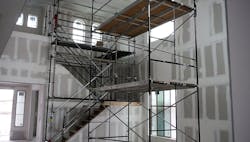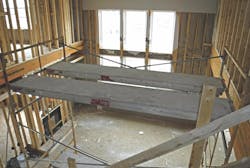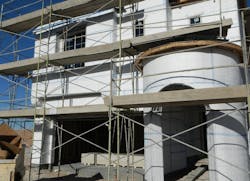Safe Scaffolding: Follow These Best Practices for Correct Setup
Some builders are surprised that IBACOS evaluates scaffolding as part of its Construction Quality Assessment Program. As a life safety item, however, a poorly constructed scaffolding setup has potentially dire consequences for workers, as well as for the builder. As such, it should be built with as much care as the house itself.
First step: Search for and read a few online articles detailing the basic OSHA-approved guidelines for safe scaffolding. It’s always a good idea to refresh your memory about what OSHA requires and to adjust your construction safety practices, as necessary.
This article will highlight a few important construction safety details I see ignored again and again for interior and exterior scaffolding setups and will offer some easy solutions.
Interior Scaffolding Setups: Mind the Guardrails
Scaffolds set up inside the house, for jobs such as installing ceiling molding or hanging and taping drywall in a two-story vaulted space, are the worst offenders I see. Many of these scaffolds are assembled and disassembled the same day, then reassembled at other locations in the house by hurried workers who don’t heed the need for safety as much as they should.
According to OSHA, 65% of workers in the construction industry frequently use scaffolds. Of those workers, about 4,500 are injured each year, and about 60 people die from scaffold accidents.
The missing element on many interior scaffolds is a proper guardrail, or any guardrail at all (see photo, below). I’ve seen some contractors use rope or warning tape, presumably to alert workers when they’re about to step over the edge, but neither of those is at all good enough.
To be effective, guardrails must be strong enough to keep a worker from falling, which means they must be able to bear the weight of an average adult. To do so, they must be made from something substantial, like wood or steel. It’s a sound and worthwhile investment.
Exterior Scaffolding Setups: Invest in the Best
Scaffolding setups on the outside of the house are generally better, with most large, exterior scaffolds having the necessary components, such as rigid guardrails, cross bracing, and walking surfaces. Sadly, the main reason for this diligence is that no one wants to attract attention from an OSHA inspector who happens by. But another reason is that exterior scaffolds tend to stay up for longer periods of time, such as a stucco process of applying lath, foam, and scratch and final coats over several days.
While most big siding crews use manufactured scaffolds for whole-house jobs, that’s not always the case for work done 10 feet or less off the ground. There, we still see a lot of on-the-fly, field-built setups, but we advise builders against allowing this practice. OSHA provides detailed guidelines for building these types of temporary scaffolds, but almost no one follows them. That’s just asking for a fine, or worse, a serious injury. A good pipe scaffold is a wise investment that all of your trades can use repeatedly for small tasks.
A good pipe scaffold is a wise investment that all of your trades can use repeatedly for small tasks
When it comes to construction safety, it’s also important to protect people below. Workers on the ground are at obvious risk from head-crushing objects, such as tools or bricks, accidentally being kicked off the walk boards. But if a non-worker gets hit, the result likely will be an expensive lawsuit. (And don’t assume that a policy prohibiting unaccompanied home-owners on the jobsite will have foolproof enforcement.)
“Toe boards”—vertical boards placed at the inner or outer edges of the planks (see photo, above)—can protect people from falling objects. The ideal is to place toe boards all around the scaffold, but at the very least, put them where walk boards cross points of egress and traffic routes on site.
We also recommend that a scaffolding system not in use be tagged with a sign reading “Controlled Access Zone. Authorized Personnel Only” to help better ensure safety and proper protocols.
John Koenig drives quality and performance in home building as a building performance specialist of the PERFORM Builder Solutions team at IBACOS.
Access a PDF of this article in Pro Builder's February 2020 digital edition


